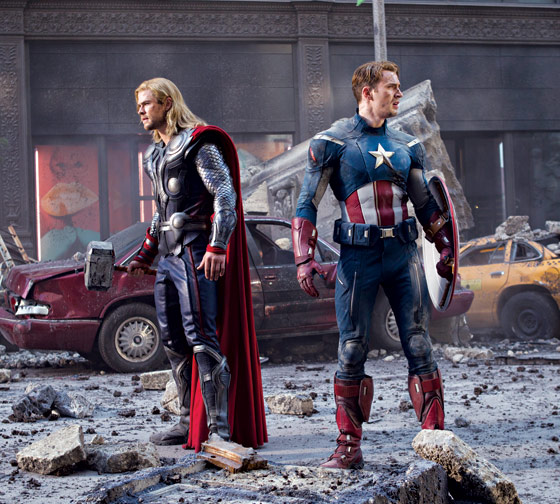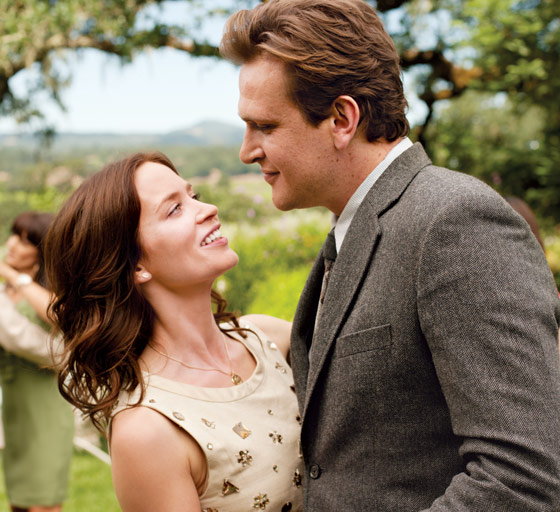
Apart from being supersmart, Joss Whedon has the perfect credentials to write and direct a colossal commercial construct like Marvel’s The Avengers: He plainly loves the opportunity to put these comic-book icons—Iron Man (Robert Downey Jr.), Captain America (Chris Evans), the Hulk (Mark Ruffalo), and Thor (Chris Hemsworth)—in one room and let them hang out, spar (with words as well as hammers, shields, etc.), and weigh the merits of individualism versus teamwork. Really—debate is as important to him as “Hulk, smash!” The movie would be all over the place if not for Whedon’s centrifugal seriousness. And it would be overbearingly pompous if not for his nifty ability to spoof his subjects without devaluing them. Like Buffy the Vampire Slayer and other Whedon wonders, The Avengers is both campy and reverential. Comic-Con nerds will have multiple orgasms. I had a blast.
I also, as I watched, thought, Wow, that must have cost a lot of money … money … money … waves of money. There aren’t many shots without fancy CGI or mighty sets occupied by dreamy men and women with finely sculpted bottoms. Even if scenes of superheroes whooshing around Manhattan and battling an armada from the realm of Asgard look like video games, you have to admire a hot-dog shot like the one in which the camera zigs and zags to catch every single Avenger in midair, bashing and crashing and hammering for all they’re worth (plenty). The frames have the thrust of good comic-book illustrations without overdoing it, and Whedon picks his moments to come at ya with 3-D: Here and there, a spear will tickle your nostril hairs. On the human front, the stunt doubles—especially Scarlett Johansson’s, whose name is, I swear, Heidi Moneymaker—are gratifyingly elastic. You might as well revel in this thing. It’s like all-day room service at the Ritz.
The villain, introduced in Thor, is called Loki and played by Tom Hiddleston, whose name invokes dyslexia—I always type, “Tim Huddleston.” By any name, he’s a magnificently theatrical presence. He’s after a tesseract that will open a portal to Asgard. The larger point is that he wants to “free the world from freedom.” He thinks that, deep down, humans long to follow orders, reminding Captain America—transformed from a puny dork to fight the Nazis—of another mad Fascist. The Avengers have a hard time focusing on Loki, though, since they drive one another loco.
We all like to play the game, “Who would win in a fight, Dracula or Frankenstein? King Kong or Godzilla? Palin or Bachmann?” Here, you get shield versus hammer. Hammer versus iron suit. Shield versus Hulk. Nobody wins, but a lot of trees, windows, and expensive-looking control panels lose. Samuel L. Jackson’s S.H.I.E.L.D. leader Nick Fury lectures his wayward charges like the world’s dullest headmaster. (Jackson brings nothing to the part.) For some reason, Whedon has the obnoxious Tony Stark (Downey) work on Bruce Banner (Ruffalo), who’s diligently practicing anger management, to let out his inner Hulk, as if their flying battleship is some kind of est seminar. Shambling, attractively mussed Ruffalo ignores him and steals every scene. Whedon gives some sweet moments to Clark Gregg as Agent Phil Coulson, now part government liaison, part fanboy. He gets especially moony around Evans’s rather colorless Captain, whose most expressive feature is his muscular torso. Multiple protagonists means that by the time you’ve had your fill of snotty Iron Man you get the wooden Captain, and when you’re bored with the Captain, you get the Norse hottie. Or Johansson, who comes into her own. Over the years, Johansson’s once-refreshing self-confidence has become an irritant (the vibe is now snobbish), but her Natasha Romanoff–Black Widow is a treat, her deadpan prickling with rage and hurt.
The Avengers is full of terrific comebacks (Captain: “We need a plan of attack.” Iron Man: “I have a plan—attack!”), and Whedon never lets us forget that, in the words of one bureaucrat, the fate of the human race has been left to “a handful of freaks.” The problem is, what now? Can we watch another Iron Man flick without thinking, “Why doesn’t he get on the phone to Banner? Natasha is rested and ready. Thor is just a portal away.” We’re spoiled. We’ll always be thinking, “Show me the money!”
A charming, funny, reactionary mating comedy from the Judd Apatow factory, The Five-Year Engagement is about a rising San Francisco chef, Tom (Jason Segel), who sets aside his career to relocate to a less-desirable city (Ann Arbor) when his fiancée, Violet (Emily Blunt), gets into a prestigious academic program—and feels his manhood slipping away. That’s what a fella can expect when he puts his woman first.

An unfair reading? No, it’s pretty explicit. Directed by Nicholas Stoller from a script he wrote with Segel, The Five-Year Engagement has a tidy scenario. Tom and Violet get engaged as fireworks erupt over San Francisco Bay. Their families celebrate. Then Violet gets accepted into the University of Michigan’s social-psychology department. She explains to Tom that her mother gave up a promising career for her father, and that she won’t make that mistake. Better to put off the wedding and pull up stakes. But once Tom hits the Midwest, this onetime culinary star is reduced to making sandwiches at Zingerman’s Deli. His new best friend, Bill (Chris Parnell), is a househusband who takes care of the kid, hunts, and knits puffy sweaters.
It should be said that Violet is not a stereotypical emasculating female, but her fate is out of her hands. There’s a subordinate couple for contrast, adorable Alison Brie as Violet’s ditzy sister, Suzie, and Chris Pratt as Tom’s immature San Francisco assistant, Alex. They drunkenly hook up, she gets pregnant, and, like the protagonists of Apatow’s Knocked Up, they end up married, with Alex taking Tom’s place as San Francisco’s new star chef. Suzie took the plunge that her sister couldn’t take, made babies, and is now snug and happy.
If you overlook its message, The Five-Year Engagement is enjoyable. It’s long—over two hours—but mainly because Stoller loves his actors and gives them room to play. Blunt blurts her lines and pulls funny faces, and what a funny, gorgeous face she has to pull. Segel’s lumbering body fits his character, who can’t keep pace with his own emotions. But that message: Do Stoller, Segel, and Apatow believe that women should be more like Suzie, for whom a drunken one-night stand and accidental pregnancy prove a blessing? As a capper, Violet’s social-psychology experiments turn out to be ridiculous and lead her, in a roundabout way, to conclude that Tom, her obvious soul mate, is all wrong for her. Those five years teach Violet and Tom nothing except that waiting—and planning and thinking—is for dumb schmucks.
The Avengers
Directed byJoss Whedon. Disney. PG-13.
The Five-Year Engagement
Directed by Nicholas Stoller. Universal. R.
E-mail: filmcritic@newyorkmag.com.
